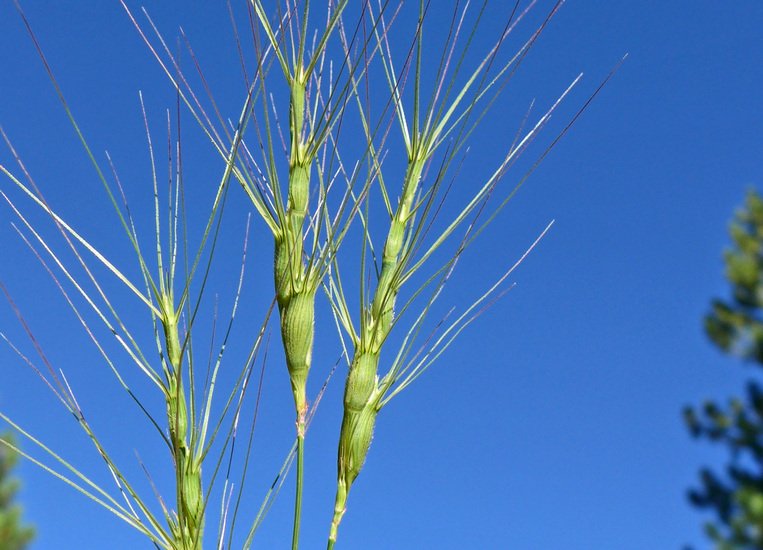The Illinois Valley is known for its crystal clear waters, complex cave systems, and old growth forests. It also boasts the distinction of hosting Oregon’s only known barbed goatgrass infestation. Barbed goatgrass (Aegilops triuncialis) is a highly invasive annual grass that can proliferate in varying dryland conditions, reduce forage quality, and harm grazing animals.
Native to Mediterranean Europe and western Asia, barbed goatgrass was introduction to California in the early 1900s through the Mexican cattle trade. The species is well-adapted to a wide variety of climatic conditions, tolerant of serpentine soil, and grows in hard, shallow, dry, gravelly sites. Once established, barbed goatgrass quickly spread through grasslands, pastures, and ranches throughout Northern California. It was first documented near Cave Junction, OR in 2003.
Barbed goatgrass is listed as an Oregon Class A noxious weed. This means it is a weed of economic importance which occurs in the state in small enough infestations to make eradication or containment possible. The state is actively managing the species for eradication or containment.
Barbed goatgrass is a winter annual grass that grows 8 to 16 inches tall with few to many culms (above-ground stems). The leaves are rigid, sharp, and pointed. Leaf sheaths contain white hairs when young, becoming more or less smooth once matured. Immature spikes are often reddish or purplish. Mature spikes have long awns which give the plant its name and help the plant disperse by animals, wind, and water. Grains are 1/4-inch-long, resembling a wheat kernel.
Why should I care about Barbed Goatgrass?
Barbed goatgrass grows in rangelands, grasslands, and oak woodlands in both disturbed and undisturbed sites. Its deep and expansive root system and slowly composing thatch can crowd out native species and desirable forage. The species is unpalatable to most livestock and the long awns in mature plants can cause serious injury to grazing animals by the barbs embedding in their noses, mouth, and eyes. Infestations can reduce forage quality and quantity by 50 to 75 percent. Barbed goatgrass is an agricultural concern since it can readily cross with wheat, producing sterile seed and unmarketable wheat.
How can I control Barbed Goatgrass?
The best way to control barbed goatgrass is early detection. Since seeds to not fall far from the mother plant, early detection of small infestations are manageable. However, the seeds can quickly disperse through livestock, wildlife, and in hay from dryland pasture. Control of large infestations is extremely difficult. Grazing animals should be removed from infested areas before plants mature to prevent seed dispersal by livestock. Known infestations should be monitored.
Various control measures have been tested with differing results. Please consult the Oregon Department of Agriculture to discuss an appropriate treatment strategy for your property.
Report Barbed Goatgrass
Have you spotted Barbed goatgrass in your area? If so, please report your sighting to the Oregon Invasive Species hotline. Reporting locations of invasive weeds will not bring enforcement upon landowners. Instead, it will bring assistance in controlling the weed, protecting our local communities, and stopping new invasions before they start!
More Information & Resources
https://anrcatalog.ucanr.edu/pdf/8315.pdf
https://www.oregon.gov/oda/shared/Documents/Publications/Weeds/BarbedGoatgrassProfile.pdf

